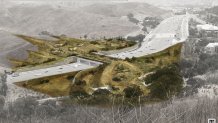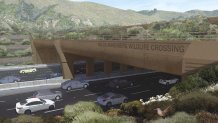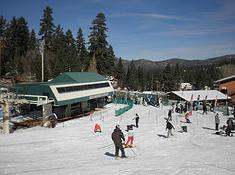Groundbreaking is set for next month on what's billed as the world's largest wildlife crossing — a bridge over a major Southern California highway that will provide more room to roam for mountain lions and other animals hemmed in by urban sprawl.
A ceremony marking the start of construction for the span over the 101 Freeway near Los Angeles will take place on Earth Day, April 22, the National Wildlife Federation announced Thursday.
The bridge will give big cats, coyotes, deer, lizards, snakes and other creatures a safe route to open space in the Santa Monica Mountains and better access to food and potential mates, said the wildlife federation's Beth Pratt.

Get top local stories in Southern California delivered to you every morning. Sign up for NBC LA's News Headlines newsletter.
“Crossings like this are nothing new," Pratt said, noting there is one outside Yosemite for toads. "This one's historic because we're putting it over one of the busiest freeways in the world.”
She helped organize the project along with other conservationists and state transportation officials.
Pratt said the bridge will be the first of its kind near a major metropolis and the largest in the world, stretching 200 feet (61 meters) above 10 highway lanes and a feeder road just 35 miles (56 kilometers) northwest of downtown LA.

Construction will take place mostly at night and won’t require any lengthy shutdowns of the 101 freeway, officials have said. It's slated to be completed by early 2025.
Local
Get Los Angeles's latest local news on crime, entertainment, weather, schools, COVID, cost of living and more. Here's your go-to source for today's LA news.
The $90 million price tag will be covered by about 60% private donations, with the rest coming from public funds set aside for conservation purposes. The span will be named the Wallis Annenberg Wildlife Crossing, for the philanthropist whose foundation donated $25 million.
Gov. Gavin Newsom called the project an “inspiring example” of public-private partnership.

“California’s diverse array of native species and ecosystems have earned the state recognition as a global biodiversity hotspot. In the face of extreme climate impacts, it’s more important than ever that we work together to protect our rich natural heritage," Newsom said in a statement Thursday.
The star of the fundraising campaign was the mountain lion P-22. Famous for traveling across two freeways and making a huge Los Angeles park his home, the big cat became a symbol of the shrinking genetic diversity of wild animals that must remain all but trapped by sprawling development or risk becoming roadkill.
Scientists tracking cougars fitted with GPS collars found over decades that roadways are largely confining animals in mountains that run along the Malibu coast and across the middle of LA to Griffith Park, where P-22 settled.
Despite being the face of the project, P-22 is unlikely to use the bridge because he’s confined to the park many miles away. But many of his relatives could benefit, Pratt said.
Some 300,000 cars a day travel that stretch of the 101 in Agoura Hills, a small city surrounded by a patchwork of protected wildland that the new crossing will connect.
Drivers in the Liberty Canyon area will speed under the bridge 165 feet (50 meters) wide with brush and trees growing on top, seamlessly joining hillsides on both sides of the lanes.
Architects designed the topography to be indistinguishable from the scenery on either side. Berms and hollows with high edges will block sound and light from the lanes below.
Wildlife crossings — bridges and tunnels — are common in western Europe and Canada. A famous one in Banff National Park in Alberta spans the Trans-Canada Highway and is frequently used by bears, moose and elk.
The Los Angeles-area bridge has enjoyed nearly universal support, unusual for a public works project. The draft environmental impact document received nearly 9,000 comments — with only 15 opposed, according to the wildlife federation.



